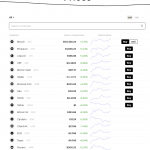Noelle Acheson is a 10-year veteran of company analysis, corporate finance and fund management, and a member of CoinDesk’s product team.
The following article originally appeared in CoinDesk Weekly, a custom-curated newsletter delivered every Sunday, exclusively to our subscribers.
When one of the world’s largest corporations gets together with one of its largest peer-to-peer (P2P) lenders, you can almost hear the market sit up.
That’s what happened last week, when Chinese conglomerate Foxconn joined forces with P2P lender Dianrong to launch a blockchain platform for working capital. The benefits to supply chains are clear: smoother cash flows for suppliers will strengthen their liquidity, lower their costs and avoid delays in delivery due to lack of funding.
What is being largely overlooked, however, is the huge impact this development could have on a different sector: finance.
According to Dianrong, millions of small suppliers do not have access to bank finance, meaning they have had to rely on invoice payments or private loans to fund working capital. The massive, latent demand for alternative financing (combined with investors’ hunger for returns) partially explains the country’s explosive growth in marketplace lending. (Today, China has the largest P2P sector in the world, with more than 2,400 platforms.)
But, the industry is currently undergoing a shake-up.
A combination of high-profile scandals, intensifying regulation and an increasing default rate is encouraging a contraction in the number of platforms. A multi-agency government report released last month went so far as to warn that as many as 90% are likely to close over the coming months.
Changing outlook
Should this change occur as projected, investment is likely to migrate to the stronger P2P lenders, shrinking the pool of potential borrowers.
Unlike most of their younger and smaller peers, reputable marketplace finance providers rely on credit scores, a practice that tends to exclude small businesses with little data and no collateral. More funds chasing fewer opportunities will lower the potential returns and weaken the profitability of the sector as a whole.
Introduce a new segment of borrowers, though, and the outlook changes.
The opportunity to lend to entities with a better-than-average risk profile at a reasonable return is the ‘holy grail’ of marketplace lending.
Businesses are generally safer bets than individuals, especially if they have validated invoices in hand. As such, the appearance of a platform that not only gathers these borrowers, but can also verify their activity and projected income could open up new opportunities for lenders.
In addition, the effects of smoothing cash flows all along a supply chain are bound to boost performance and production, which should increase demand for financing.
Ripple effects
The result will probably be an even greater inflow of funds into the sector as its reputation improves.
Furthermore, a greater concentration of marketplace lending activity and a more reliable flow of available data would make it easier for regulators to shine a light on ‘shadow banking’. This could accelerate the shift away from traditional finance and blur the boundaries between the two.
The emergence of a new outlet for funds could even end up affecting international capital flows.
As bitcoin exchanges have learned, China’s central bank has long been struggling to stem the tide of money moving outside of the country in search of better returns. An appealing domestic alternative that has the added benefit of boosting manufacturing is likely to attract the support of the authorities, ushering financial and strategic incentives for platforms and borrowers.
And, of course, there’s the impact blockchain development.
The alternative lending sector is still a tiny part of the overall economy, and blockchain is today a minuscule part of that. But, there are no small numbers in Chinese finance.
Although the project was designed for supply chains, its eventual effects could follow the law of unintended consequences, shaping trends in finance and beyond.
Click Here to Never Miss a Weekly Email Again
Stained glass image via Shutterstock
Disclaimer: The views expressed in this article are those of the author and do not necessarily represent the views of, and should not be attributed to, CoinDesk.














